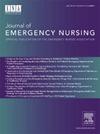1例血清血糖为2394 mg/dL患者的急诊护理
IF 2.3
4区 医学
Q2 EMERGENCY MEDICINE
引用次数: 0
摘要
背景:糖尿病酮症酸中毒是由糖尿病患者胰岛素供应不足引起的一种医学急症,通常由感染引起。糖尿病酮症酸中毒的治疗有很好的记录,包括短效胰岛素、液体和电解质纠正的管理,一些研究描述了糖尿病酮症酸中毒与2019冠状病毒病之间的可能关系,导致极端高血糖。患者表现:本病例回顾了一位34岁女性患者的急诊护理管理,她因可能的糖尿病酮症酸中毒而出现代谢极端。血清血液分析结果显示,血糖2394 mg/dL,酮45.32 mg/dL,钾6.1 mmol/L,体温过低,冠状病毒2019阳性,进行性椎体扭力。治疗策略集中于气道管理,适当的强直和渗透压矫正,以及电解质紊乱的纠正。结论:该患者转至三级医院,出院时无生理缺陷。本病例回顾旨在告知糖尿病酮症酸中毒患者极端高血糖的处理方法。本文章由计算机程序翻译,如有差异,请以英文原文为准。
Emergency Nursing Care in a Patient With a Serum Blood Glucose of 2394 mg/dL: A Case Review
Background
Diabetic ketoacidosis is a medical emergency arising from insufficient insulin supply in diabetes and is commonly triggered by infection. Management for diabetic ketoacidosis is well documented, which involves the administration of short-acting insulin, fluids, and electrolyte correction, with some studies describing a probable relationship between diabetic ketoacidosis and coronavirus disease 2019, resulting in extreme hyperglycemia.
Patient Presentation
This case review details the emergency nursing management of a 34-year-old female who presented in metabolic extremis from probable diabetic ketoacidosis. Serum blood analysis results revealed a blood glucose of 2394 mg/dL, a ketone level of 45.32 mg/dL, a potassium level of 6.1 mmol/L, unmeasurable hypothermia, coronavirus disease 2019 positivity, and progressive torsades de pointes. Management strategies focused on airway management, suitable tonicity and osmolarity correction, and rectification of electrolyte derangements.
Conclusion
The patient was transferred to a tertiary care hospital and discharged home with no physiological deficits. This case review aimed to inform the management of extreme hyperglycemia in diabetic ketoacidosis.
求助全文
通过发布文献求助,成功后即可免费获取论文全文。
去求助
来源期刊
CiteScore
3.10
自引率
11.80%
发文量
132
审稿时长
46 days
期刊介绍:
The Journal of Emergency Nursing, the official journal of the Emergency Nurses Association (ENA), is committed to the dissemination of high quality, peer-reviewed manuscripts relevant to all areas of emergency nursing practice across the lifespan. Journal content includes clinical topics, integrative or systematic literature reviews, research, and practice improvement initiatives that provide emergency nurses globally with implications for translation of new knowledge into practice.
The Journal also includes focused sections such as case studies, pharmacology/toxicology, injury prevention, trauma, triage, quality and safety, pediatrics and geriatrics.
The Journal aims to mirror the goal of ENA to promote: community, governance and leadership, knowledge, quality and safety, and advocacy.

 求助内容:
求助内容: 应助结果提醒方式:
应助结果提醒方式:


